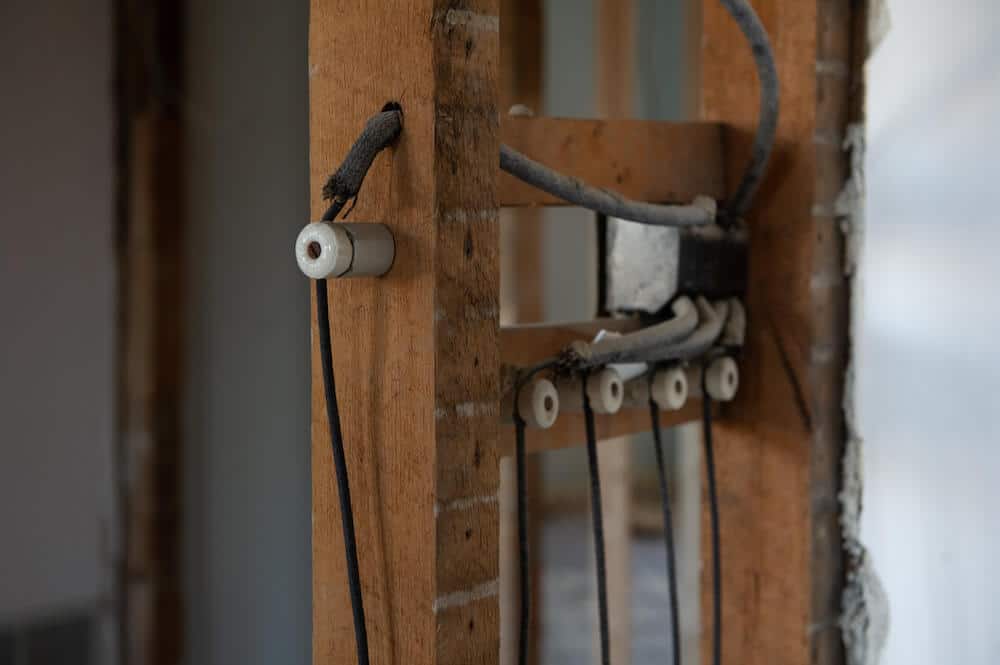Do you know what could be lurking beneath your insulation? Most homeowners wouldn’t bother to find out unless they needed to swap out old insulation. And even then, who would think there would be anything to find?
But for California homeowners, there could be something you want to address lying underneath: knob and tube wiring. This type of wiring was common throughout the country until the early 1940s. It’s mostly eradicated from use and is typically not permitted under the National Electrical Code, save for a few specific circumstances.
So why would you want to know if you have knob and tube wiring? Here’s a look at the advantages and disadvantages and why it was eventually phased out of use entirely.
What Is Knob and Tube Wiring?
This old-school wiring has multiple components, including ceramic knobs, electrical wires, ceramic tubes, cleats, and a loom. These pieces work together to bring electrical power to an outlet or device. Provided an electrician installed this system correctly, there’s nothing inherently unsafe about using this wiring.
But the chances of that are relatively slim. Since most homes won’t have had new knob and tube wiring within the past fifty or more years, most of these systems have a high likelihood of being damaged or modified in some way.
Advantages
Surprisingly, there are still some arguments you can make for knob and tube wiring, though most of them don’t apply to modern-day homes. A big reason why knob and tube wiring still saw use that outlived its welcome is because of its low cost.
Conduit methods in the early 1900s were available but much more expensive than their knob and tube counterparts. Despite technological advancements, this price difference kept this electrical system relevant.
Most of the components within the system also have an incredibly high lifespan if appropriately treated. For example, porcelain standoffs last virtually forever, keeping bare wires safe from damage. These standoffs are actually still used in other applications like electric fencing to keep livestock in. This is not necessarily a glowing review for having them in your home, but proof that they’re effective at what they do.
Disadvantages
The most notable issue with knob and tube wiring is that the system was never intended to supply the amount of power most homeowners use today. Modern electrical wiring runs circles around a knob and tube system, quickly powering just about anything you’d need in your home without issue.
Household power consumption increased dramatically, and electrical systems were revamped to supply the demand. Now that we’ve come as far as we have with technology, there’s no real reason to suggest that a knob and tube wiring system would have any concrete benefits in a modern home.
Another significant disadvantage and safety issue is that this system never included the always-important safety grounding conductor. It’s also much more prone to damage from building renovations, so it’s essential to locate it if you’re planning an attic renovation or installing new insulation.
Should a homeowner use these systems with modern power and safety standards in mind, there’s a higher chance of overloading the circuits and causing heat damage or fire. These systems are also easily damaged by pests like rodents or even through accidental exposure.
Why It Needs to Go
Despite this unique wiring system’s ability to function safely within homes, most professionals would highly recommend replacing it. But why? What benefits would you get from switching out your system?
The bottom line is that outdated wiring can be dangerous. Even if you don’t have a knob and tube system, the older your wiring is, the more likely it is that you’ll run into problems. If you find this system when working on a home improvement project or looking into purchasing a home, professionals recommend swapping it out for a modern electrical system.
A project of this magnitude sounds expensive and very well could be. But to ease your mind a bit, know that old wiring is nowhere near as efficient as current systems. So if you’re powering your home on an older system, you’re likely paying much more than you would if you had an electrical system built to withstand your needs.
Most people’s energy consumption nowadays will require something more sophisticated than the knob and tube electrical system. It’s been phased out of new homes for decades, and just because it technically can operate doesn’t mean that using one is doing you any favors.
How to Know for Sure if It’s a Problem in Your Home
You might be aware of your knob and tube wiring system and think it’s working perfectly fine. Or you might be unsure of how your system works and need peace of mind. If you don’t have a clear picture of how your home’s electricity works, it doesn’t matter what system you have — you deserve to have all the answers.
This is where calling a professional for an electrical wire inspection comes in. Faulty and outdated wiring, regardless of how it is set up, can cause electrical fires that can irrevocably damage your home and property.
After your inspection, the electrician can discuss ways to repair or replace your system. If you’re concerned, only work with electrical professionals who have experience working with this specific type of wiring, as it requires specialty knowledge to handle it correctly.
Knock Out Knob and Tube Wiring in Your Home
Bad wiring can cause fires, shocks, and power surges — and they can all happen when you least expect it. If you suspect you have a knob and tube wiring system, there’s a much higher chance your wires are old or damaged, making it more likely to cause problems or become a fire hazard.
The Attic Projects team is here with professional electrical inspections for California Homeowners. Get the information you seek today by scheduling a free inspection. Our inspections include detailed reports with suggested next steps to keep your home running smoothly and safely. Contact us today to learn more!




